FROM TORRENTS TO TRICKLES
Hardly a year passes without a disastrous flood in the United States. Such a flood may strike only a small area or may devastate a great river basin like the Columbia, Missouri, Mississippi, or Ohio. In the spring of 1965, a great flood in the Upper Mississippi River Basin caused about $150 million damage. In the spring of 1948, the Columbia River Basin had a damaging flood. More than 40 lives were lost, 60,000 persons left homeless, and property damage was estimated at $200 million. In 1955 floods in New England caused property damage amounting to $1 billion. Late in 1964 widespread flooding in the Pacific Northwest left about three-fourths of a billion dollars in property damage in its wake.
These were, indeed, great flood disasters. But smaller floods also occur year after year on the tributary streams of our major rivers, and they too cause great damage. The estimated annual loss from all floods in the United States averages slightly more than $1.7 billion.
While this uncontrolled water plays havoc in some sections, others are faced with water shortage. For example, the growth and development of the Southwestern United States is hampered by too little water. Surface waters of this area are almost entirely utilized and ground water is being pumped at a rate that exceeds the estimated recharge. This is most critical in central Arizona where average depths to ground water are increasing at an annual rate of 10 feet, and in excess of 20 feet in some localities. As water becomes scarcer, wells must be dug deeper, pumping costs increase, and—sooner or later—new supplies must be found. Record low-water levels also were reported for several Northeastern States in the fall of 1964.
Several factors determine how the land helps to provide water. Although man is now attempting to modify the weather, having successfully increased local precipitation on occasions, by and large geologic conditions and climate are factors over which man cannot exercise control. But man has a choice in what he does with watershed lands and in the plant cover he develops upon them. Unhappily, through most of his history, civilized man has abused that choice.

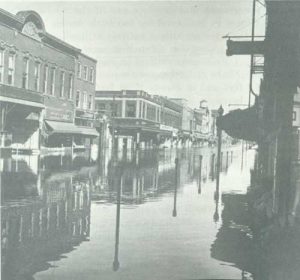
Devastating floods occur somewhere in the United States nearly every year. F—444307, F—444226
NATURE'S WATER FACTORY
Everyone knows that water falls from the clouds as rain or snow. Less obvious is the huge system working endlessly within the atmosphere, somewhat like air conditioning, to circulate and distribute the earth's moisture. This unending circulation is called the water cycle, or hydrologic cycle. The heat of the sun evaporates water from the surfaces of oceans, lakes, and soils. This moisture is lifted into the atmosphere where it cools and condenses to form clouds from which water returns to the earth as rain, snow, sleet, or hail. Some water falls into the ocean and is immediately recycled, but the water that we can use falls upon watershed lands.
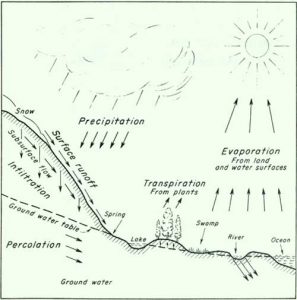
The hydrologic cycle.
After rainwater finds its way to the ground, it may flow over the surface into streams, soak deep into the soil, or return to the atmosphere by evaporation. Some water intercepted by plant foliage and nonporous surfaces adds to that in the ground and some is immediately returned to the atmosphere by evaporation. Ground water used by growing plants slowly seeps through the soil, recharging aquifers and maintaining streamflow throughout the summer. Streams feed rivers. which return the water to the oceans, renewing the water cycle.
Thus, most of the water we use is first absorbed by the soil, then returned to the surface as seepage in springs, streams, and lakes, or by being pumped from wells. Because soil is a filter, the emerging water is usually clean and clear. We should not forget that the quantity of water available to us depends largely on the amount of rain and melted snow stored in the ground and to a lesser extent on amounts stored in reservoirs.
WATERSHED CONDITION
Simply put, a watershed is a drainage basin, an area of land from which a stream gets its water supply. The watershed may be as small as the upland drainage of a farm pond or as large as the Mississippi River Basin. It then becomes more than a combination of hills, valleys, streams, forest, grass, farm crops, and soil. A large watershed also includes cities, people, roads, and animals. Wherever you live, you are in a watershed and are part of a watershed community.
You can easily recognize a watershed that is in good condition. Except in arid and semiarid areas, plants and organic residues protect most of the soil surface on wild lands. Leaves and branches of trees, shrubs, grasses, and other plants break the force of falling raindrops, and dead plant material on the ground prevents rain from loosening soil particles and splashing them about. Under these materials the soil is soft and porous because it is mixed with organic matter. Water seeps into channels made by plant roots and burrowing insects and animals. Going deeply into the ground, clear water can return to the surface as springs, seeps, and streamflow—sometimes even during the driest seasons.
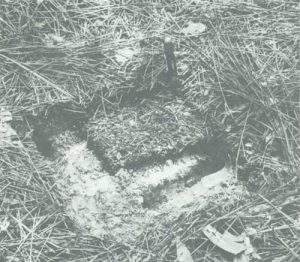
Deep, spongy ground cover on a healthy watershed. F—324514
Quite a different situation prevails on watersheds where protective plant cover is absent. Falling raindrops gouge and batter the soil like many small bombs. Soil is lifted and splashed back and forth, and the churning action of the drops beats the soil into a pasty mud. Pores and channels through which water might enter the soil become clogged, and water collects on the ground surface. Soon this water races overland to streams, carrying large amounts of topsoil to be dumped into reservoirs or on lowlands. Water polluted with sediment is all but useless without expensive treatment.
The condition of a watershed determines how well the watershed works for us. When it rains, a watershed covered with vigorous plants and a layer of dead and decayed vegetation (humus) acts like a blotter or sponge. Water sinks deeply into the ground instead of rapidly flowing off the surface and washing soil away.
Occasionally even a well-conditioned watershed may not control all the water. Floods may occur during extremely heavy rainfall, rapid snowmelt, or when soils become saturated. But well-forested and well-sodded watersheds will delay the water in its passage to the streams. On these watersheds only small amounts of injurious sediment and debris are carried by floodwaters.

Raindrops falling on bare soil— SCS PHOTO 74887A
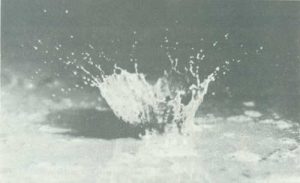
—gouge and batter it like small bombs. SCS PHOTO 74887D
WATERSHED USES
The simplest way to safeguard watersheds might be to lock them up—exclude everybody and everything for all time—and let nature take care of them. There is evidence that water is cleaner and the yield better regulated on undisturbed watersheds.
But water is only one product of the land. Watersheds provide other valuable and necessary benefits and uses—trees for lumber, paper, and other wood products; crops, forage for livestock and game animals; minerals; hunting and fishing, driving, hiking and strolling, and other recreation. If carefully planned, these other uses need not impair the yield or quality of water from a watershed.
Other uses must be made of watershed lands, but with caution. Farmlands require proven farming practices to prevent soil erosion and water waste. On uncultivated lands—the most important, water-yielding areas—uses like grazing, logging, hunting, and camping must be carried out so that surface runoff and erosion are not speeded up and streams or underground water supplies are not polluted.
Watershed lands in the National Forest System are managed for "multiple use." Under this concept all resources are utilized for the greatest benefit to the most people in the long run. Careful long-term planning is needed to meet this objective and at the same time protect our forest environment for future generations.
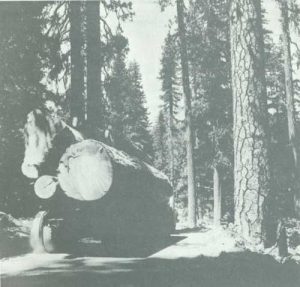
Well-managed watersheds can provide wood— F—499403

—forage— F—499851
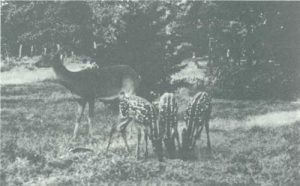
—habitat— F—246931
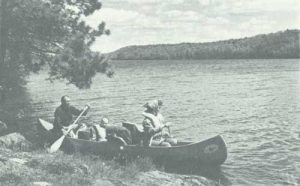
—recreation— F—512346
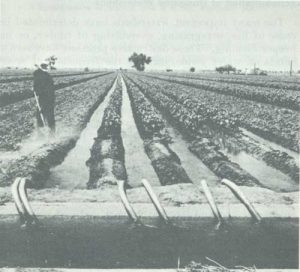
—and ample water for our needs. F—49177
WATERSHED MANAGEMENT IS THE KEY
To obtain steady and abundant high-quality streamflow and to prevent damaging floods, watersheds are managed toward three broad goals: Rehabilitation, protection, and water yield improvement.
Rehabilitation of Damaged Watersheds
Too many important. watersheds have deteriorated because of fire, overgrazing, overcutting of timber, or improper farming. These destructive practices have serious effects on water yields, increase the frequency of severe floods, and lower land productivity. Watershed rehabilitation has received much consideration because our growing population requires more space and more products from the land.
The first step in rehabilitating a watershed is removing or discontinuing the cause of damage. If unwise use has damaged a watershed, that use should be reduced or terminated. The next step is to establish a good protective covering of vegetation. This may require the use of gully plugs, small drums, terraces, or furrows; but permanent vegetation is the lasting way to stabilize bare, eroding soil and restore the natural environment.
Such was the need in Davis County, Utah. Years of overgrazing and trampling by livestock on the mountain slopes had destroyed nearly all protective soil cover. Summer cloudbursts caused damaging flash floods. Huge quantities of mud and rocks washed down into fertile valleys. Roads and railways were blocked, buildings were wrecked, and nearly 2,000 acres of farms and orchards were ruined. Between 1923 and 1930, these floods took a toll of six lives.

Rehabilitation of eroded land is a big, expensive job. F—480725
Then came decision and action. Private rangelands in the watershed were bought and placed in public ownership. Grazing was reduced or excluded. From 1933 to 1939, contour trenches were built on some 1,300 acres of the barest slopes to prevent soil wash while plants were being established. By the end of the second summer, grasses and native shrubs were growing vigorously. After this expensive initial treatment of a small part of the watershed, other parts are recovering. Yet several more decades will pass before full recovery is reached. Until then no grazing may be permitted, and the watershed must be protected from fire.
On September 8, 1959, someone in the Black Hills region of South Dakota permitted a trash fire to escape to the forest. Over 4,500 acres of valuable woodland was burned, and the city of Deadwood exposed to a serious flood threat. Decision was prompt, and an emergency rehabilitation program was applied before heavy rains fell. Trenching held the soil in place, and aerial seeding restored the cover. Rainfall in 1962 was more than three times the average for the area, but flooding and mud and rock flows were prevented.
Thus, damaged watersheds can be repaired. Man, working in cooperation with nature, can reverse the effects of his own misdoing. Restoration is slow and expensive, but possible and more than rewarding.
"He is the greatest patriot who stops the most gullies."
—Patrick Henry.
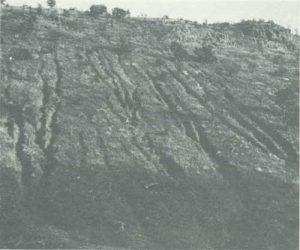
Continued overgrazing leads to serious erosion. F—68540
Protection of Good Watershed Condition
Conditions in several Western States illustrate the need for environmental protection. Demand for lumber has pushed the harvest of timber farther and farther into the high mountains—the headwaters of important rivers. Stands must be logged so as to insure future tree crops. Roads must be properly located and built to prevent soil from washing into streams. And fire danger increases after logging because great amounts of dry twigs and branches are left on the ground. New logging methods and equipment are being developed to protect soil and water quality.
At the same time, forest grasslands furnish valuable summer forage to great numbers of livestock. The intensity of grazing must be closely watched to avoid excessive soil trampling and to maintain a good protective cover.
Water Yield Improvement
To improve water yield is desirable, but it has received little attention in the past. This is understandable because protection and rehabilitation are the minimum jobs necessary for survival, and water supplies have generally been adequate. But ever-increasing demands on water reserves are focusing more attention on the opportunities for better water yield from forested watersheds.
Since all plants use water—some more than others—important changes in vegetation patterns are possible. Increased water yields have been demonstrated. In areas of deep snowpack, streamflow may be increased by cutting the forest in special patchwork patterns. Where the trees are removed, more snow reaches the ground to slowly melt in the spring, and fewer trees use the water stored in the soil. The patches of uncut trees protect the cut areas against wind and sun and prevent, rapid runoff and erosion.
Water is at a premium in the dry Southwest. Here the flood plains and banks of many streams support dense stands of high water-consuming plants. These plants, called phreatophytes, grow where their roots tap the ground water. They use water wastefully and some of them may be replaced by a protective cover of shallow-rooted plants, such as grasses, to increase water supplies for people living downstream. Benefits from increased water supplies must be weighed against other resource benefits provided by these deep-rooted plants, however. (Water yields have been increased simply by cutting trees along streamsides in the more humid eastern parts of the country as well as in the Southwest.) Another and perhaps more promising means of increasing water yields in the Southwest is through reduction and control of vast areas of dense brush. This practice also provides other benefits such as better fire control and improved wildlife habitat.
Improvement of high quality water yields on a large scale is a project of the future, possibly one of the most important goals of watershed management. Here we can help nature. Through our own efforts we may tailor a watershed to meet our needs.

Aerial view of an experimental timber cutting to improve water yield. F—485359
WHAT IS BEING DONE?
Public responsibility in the care and use of watersheds has long been recognized by our local, State, and Federal governments. Publicly owned lands comprise more than one-fourth of the United States; most of these are important rural or forested watershed lands. The Federal Government, through some 13 agencies, manages 765 million acres. This includes 183 million acres of National Forests—the highest water-yielding lands in most regions—and 4 million acres of National Grasslands. States own about 84 million acres, much of which is in State forests, parks, and wildlife reserves. About 4.5 million acres are included in community forests, and many of these are forests from which cities get their water.
More than 40 million acres of National Forest lands supply water to 1,100 communities for domestic and industrial uses. Thus, about 20 million people in these communities are directly dependent on National Forest watersheds for all or most of their daily water supply. Yet 92 percent of these watershed lands are used for logging, grazing, mining, fishing, hunting, and recreation—the remaining 8 percent have at least one use other than water production.
Some publicly owned watersheds are being managed, and others have possibilities of this being done. Cities like Newark, N.J., Asheville, N.C., and many others have found it necessary to own and manage their watersheds to protect water supplies. Other cities have purchased strategic lands and turned them over to the forest Service to be scientifically managed along with the National Forests.
The most sensational water problem occurs when heavy rains or rapidly melting snows flood low-lying areas along major rivers. As authorized by the 1936 Flood Control Act, the U.S. Army Corps of Engineers builds large dams, levees, and related works on main rivers to reduce or prevent flood damage. Continued operation of these big dams is necessary to provide long-term flood protection, but sediment from upstream erosion greatly shortens their useful life. Therefore, any activities that reduce rapid runoff and erosion will greatly help the operation of flood control dams, levees, and waterways, and prolong their useful lives.
For these reasons, private landowners are encouraged to use land resources wisely. A landowner cannot always pay for structures or other expensive installations, so he is encouraged to use public technical assistance. Four out of five farms and ranches are in Soil Conservation Districts, locally organized and managed to assist in planning and applying conservation measures. Public forestry assistance is available to small woodland owners in establishing, protecting, and managing farm woodlots.
Since 1954 when Public Law 83—566, The Watershed Protection and Flood Prevention Act, went into effect, many rural and urban communities have joined in projects to reduce soil erosion and excessive runoff from rural lands. These projects are combining land conservation with needed small structures for flood prevention and water management on tributary watersheds of 250,000 acres or less. Many of these projects produce important benefits in water supply, recreation, and fish and wildlife habitat.
Extensive research by universities, State agricultural experiment stations, and Federal agencies is seeking new methods for improved watershed management and water use. The Forest Service is studying the influence of different kinds of grass, shrubs, and trees on the ability of soil to absorb and store water. It is learning how much logging, road construction, and grazing can be applied without damaging watershed and other environmental values. It is also studying the basic problems in water production—how water moves through the soil, how much water is used by different plants and combinations of plants, how the soil may be kept porous and spongy, how soil erosion may be reduced, and how water yields may be increased by scientific management of vegetation, snow, and soil. New studies designed to protect and improve water quality in forest areas are being started. As quickly as answers are found, they are translated into improved methods of management and put into practice.
YOU CAN HELP
As water users we can protect our interests in watersheds in several ways. First, become familiar with environmental conditions on the watershed from which our community gets water. The next time you go hiking, camping, hunting, fishing, or for a Sunday drive, see for yourself how the land is being treated. Here are clues to look for:
1. Is the ground well covered with grasses, shrubs, or trees?
2. Does the use the land now receives allow the plants to reseed and reproduce young plants?
3. Do the shrubs and trees look strong and healthy?
4. Is there a layer of dried grass, leaves, and small twigs over the ground?
5. Does the ground feel soft and springy underfoot?
6. Where gullies are present, are they eroding?
7. Are the streambanks receding and washing away?
8. Do the streams run muddy during or after rains?
9. Is there evidence of stream pollution that could endanger the welfare of towns and cities below?
If the answer is "Yes" to questions l through 5 and "No" to questions 6 through 9, our watershed is in good condition. If it is "No" for the first five questions and "Yes" for the last four, our watershed is in poor condition and trouble lies ahead.
When we know our watershed and how it is being used, we can find out from public officials and other informed sources whether its management is adequate. We should make our interests and ideas known to the persons and agencies responsible for watershed management. It is up to everyone to give careful thought and constructive support to good watershed management. What happens on our watersheds can well determine whether we—our community and Nation—will continue to prosper and progress.
"The history of every nation is eventually written in the way in which it cares for its soil."
—Franklin D. Roosevelt
For local information on watershed management and soil, water, and forest conservation on National Forests and National Grasslands, and related forest and rangelands, see your Forest Service District Ranger. For other forests and related rangelands, see your State Forest Officer or Extension Forester. For information on watershed improvement opportunities under Public Law 83—566, see your local Soil Conservation District supervisor or nearest office of the Soil Conservation Service.

